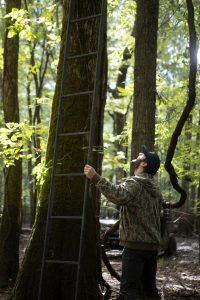Many hunters have questions about treestand placement. “How high do you go in the tree” is one of the most asked questions on the topic. Every situation is different and there aren’t any rules where there aren’t exceptions. However, there are some general practices that will help in most situations when placing a treestand.
Find a Pinch-Point
You’ll typically find more traffic if you can locate a bottleneck since often many trails are reduced to one. Because their movement is restricted to a smaller zone, it’s much easier to place yourself within that zone to remain undetected from the sophisticated sense of smell.
 Place your stand high
Place your stand high
Every situation is different, but, in most cases you’re best to place your stand as high as you can go in a tree without limiting your shot opportunities. If you’re uncomfortable with heights, go as high as you dare. Getting up the tree higher usually lets you see further, makes it harder for the deer to see you, and most importantly, your scent isn’t concentrated at their “nose level.”
Use the available cover
This somewhat goes hand in hand with treestand height – in a bald tree you’re more likely to go higher than in a tree with good cover. Look for trees that lose their foliage late, clusters of trees, or trees with a “Y” in the trunk for concealment.
Play the wind and thermal
Once you have your general area selected, pay heed to the wind and thermal current in the area. You want to remain downwind or cross-wind of where you think the deer will be.
Use the sun
Determine where the sun will be when you want to hunt the site. Do you like to look into the sun? Neither does a deer! In fact, we have a UV filter over our eyes, a whitetail doesn’t.
Pick a tree that will be easy to climb, or make it easy to climb the tree you’ve chosen.
If you have a great spot, but you alert every deer within 400 yards by making a commotion while climbing to your stand, your great spot will go for not. Use enough tree-steps or climbing sticks so you can scale the tree easily, safely and quietly.
Prepare the site to make the shot
So you have a good spot, you have a stand in the perfect tree, but what happens if a deer walks through and there’s no way you can take a shot? Take the time to trim some shooting lanes or “windows” so you can sneak an arrow through when the “moment of truth” arrives.
Be prepared in case things don’t go as planned
In case a buck does swing downwind, use a solid system of scent reduction. I’ve witnessed the Scent Killer system fool a mature buck’s nose time and time again. I feel it protects me from mistakes and from the unexpected. Can you get “totally scent free?” I don’t think that’s possible to a sense of smell that is as sophisticated as a whitetails’, however, I am positive that you can reduce odors to diminutive “trace levels” that even mature bucks will tolerate in close proximity.
Remember, there’s nothing wrong with a good ground blind. But with whitetails you’ll need to set the blind well in advance of the hunt or “brush it in” well to blend in with the surroundings. A turkey will walk right up to a blind out in the middle of an open field, but a whitetail is much leerier. Blinds have some advantages that treestands don’t; there aren’t any severe shooting angles out of a ground blind, your scent stays somewhat confined in the blind, and you can use one pretty much anywhere.
Join our weekly newsletter or subscribe to GameKeepers Magazine.
Your source for information, equipment, know-how, deals and discounts to help you get the most from every hard-earned moment in the field.


 Place your stand high
Place your stand high


